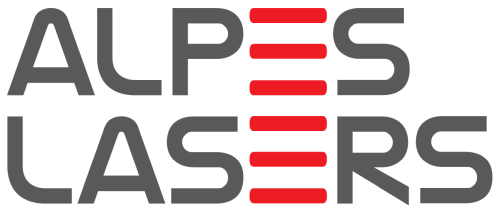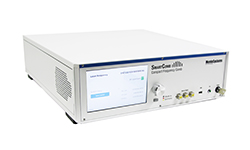beat note (original) (raw)
Definition: an oscillation of the optical intensity arising from the superposition of light with different optical frequencies
Related: frequency metrologyoptical frequencyphotodetectorsoptical heterodyne detectionBeat Signals with Zero LinewidthNo Beat Note for Orthogonal Modes
Page views in 12 months: 3596
DOI: 10.61835/ua7 Cite the article: BibTex BibLaTex plain textHTML Link to this page! LinkedIn
Content quality and neutrality are maintained according to our editorial policy.
📦 For purchasing frequency comb sources, use the RP Photonics Buyer's Guide — an expert-curated directory for finding all relevant suppliers, which also offers advanced purchasing assistance.
Contents
What is a Beat Note?
If two laser beams with different optical frequencies are superimposed on a photodetector measuring the optical intensity, a beat note — i.e., a signal with the difference of the optical frequencies — can usually be observed, if some conditions are met:
- The spatial distributions of the two light fields must overlap and must not be orthogonal. (For example, there may be no beat note if a laser beam with TEM00 and TEM01 modes excited hits a detector.) Somewhat clipping the beams, or even just some non-uniformity of the detector surface, can solve that problem.
- The polarization states also must not be orthogonal.
- The optical frequency difference must be within the bandwidth of the photodetector.
- Obviously, the wavelengths must be within the range where the photodetector is sensitive.

Figure 1: Superposition of two optical oscillations with a frequency difference of 25 THz. The bottom two curves show the electric field strengths of the isolated oscillations, and the top curve the additive superposition. A sufficiently fast intensity detector would record an oscillation of the power with the difference frequency. (In practice, beat note frequencies need to be much smaller for beating to be detected.)
As a fast photodetector can have a bandwidth of tens of gigahertz (or even higher), optical frequency differences of that order of magnitude can be measured e.g. by analyzing the photodetector output with an electronic frequency counter or an electronic spectrum analyzer. An important application of this is in frequency metrology. For example, the frequency of some laser can be measured by recording a beat note between that laser and a close-by optical signal with known optical frequency. Such measurements are greatly facilitated by an optical frequency comb which can cover a wide range of well-defined optical frequencies, so that a sufficiently nearby reference frequency for a beat measurement can be found for any optical frequency in that large range.
Optical beat notes are essential for the technique of optical heterodyne detection.
Linewidth of Beat Notes
The linewidth of a beat note of two free-running lasers with uncorrelated laser noise (which is the usual situation) is larger than the linewidth of each laser separately. For Lorentzian line shapes, the linewidth of the beat note is the sum of the individual laser linewidths. For Gaussian lines, there is a different rule: \Delta \nu = \sqrt{(\Delta\nu_1)^2 + (\Delta\nu_2)^2}$$
If the phase noise of both lasers is at least partially correlated, the beat linewidth can even be smaller than that of each laser. In an extreme case, one of the lasers may be phase-stabilized so as to obtain a constant beat frequency, as defined e.g. by some electronic oscillator. The linewidth of the beat note, measured against a clock in synchronism with the electronic oscillator, can then be exactly zero, if the phase difference exhibits only small stationary fluctuations.
Frequently Asked Questions
What is an optical beat note?
It is an electronic signal generated by a photodetector when two light beams with different optical frequencies are superimposed on it. The frequency of this signal equals the difference between the two optical frequencies.
What conditions are necessary to observe a beat note?
The two light beams must have overlapping spatial distributions and non-orthogonal polarization states. Also, their frequency difference must be within the photodetector's bandwidth, and their wavelengths must be in its sensitivity range.
What is the linewidth of a beat note?
For two lasers with uncorrelated noise, the beat note's linewidth is the sum of the individual laser linewidths. However, if the phase noise of the lasers is strongly correlated, the beat note linewidth can be much smaller.
What are beat notes used for?
A primary application is in optical frequency metrology for measuring a laser's frequency by beating it with a reference laser of known frequency. Beat notes are also essential for optical heterodyne detection.
Suppliers
Sponsored content: The RP Photonics Buyer's Guide contains 15 suppliers for frequency comb sources. Among them:
⚙ hardware
Alpes Lasers offers mid-IR frequency combs centred around 6 μm or 8 μm. The QCL comb is a stand alone device as it integrates the pump laser and the microcavity in its waveguide contrarily to other comb technologies. This makes it a very compact comb source. Being based on QCL technology, comb devices can be manufactured over all the MWIR and LWIR.
💡 consulting🧰 development🎓 training

RP Photonics offers competent consulting and tailored training courses on frequency comb sources. There is detailed expertise, e.g. on mode-locked lasers and noise sources determining the noise performance of frequency comb sources.
⚙ hardware
The K2-1000-mini is a next-generation 1 GHz repetition rate femtosecond laser, engineered for high-power, ultra-low noise frequency comb generation. This delivers massive increase in power per comb line, significantly boosting signal-to-noise ratio for precision metrology applications.
Designed for turnkey integration, K2-1000-mini features:
- High peak power for efficient supercontinuum generation across a broad spectral range.
- Compact, quasi-monolithic design, ensuring robustness and high long-term stability.
- Dual-comb modelocking option from a single cavity.
Proprietary dual-comb modelockng technique eliminates active stabilization, simplifying system integration and enables direct dual-comb spectroscopy, reducing complexity.
With its GHz-class performance, compact form factor, and unmatched dual-comb capability, the K2-1000-mini sets a new standard for frequency comb sources in scientific and industrial applications.
⚙ hardware
As the pioneer in the optical frequency comb technology, Menlo Systems offers a full product line from the compact and fully automated SmartComb to the ultra-low noise optical frequency comb FC1500-ULNplus. Our patented figure 9® mode locking technology ensures lowest phase noise and long-term reliable operation.
⚙ hardware
The MENHIR-1550 SERIES is the first 1-GHz turn-key femtosecond laser at 1550 nm, offering an ultra-low noise optical frequency comb with wide comb-spacing. This product is hermetically sealed and integrates both laser and electronics into a single unit, designed for low phase noise, high reliability, and robustness.
⚙ hardware
The RUBRIComb® Frequency Comb is built and optimized for leading lab hero experiments and rugged field use. 20G shock tested and capable of transferring sub-hertz linewidth stability. Stays phased locked for days, weeks, months, years.
RUBRIColor™ is a modular extension of the RUBRIComb™ platform that drives selectable wavelengths from 490 nm up to 2000 nm, offering a dramatic increase in leading lab hero experiments and rugged field use, thus driving reduced complexity while increasing stability for quantum computers, optical clocks, quantum sensors, and quantum networking.
⚙ hardware
TOPTICA’s Difference Frequency Comb (DFC) is a compact, robust and high-end solution featuring turn-key operation in a 19 inch format. The patented CERO technology uses difference frequency generation to intrinsically fix the _ν_CEO at 0 Hz. This allows for one control loop less compared to standard f–2f approaches, resulting in lowest CEP noise and a decoupling of _ν_CEO and _f_rep. Thus, the DFC is the number one choice for anyone looking for high-end performance combined with a high level of robustness.
Questions and Comments from Users
Here you can submit questions and comments. As far as they get accepted by the author, they will appear above this paragraph together with the author’s answer. The author will decide on acceptance based on certain criteria. Essentially, the issue must be of sufficiently broad interest.
Please do not enter personal data here. (See also our privacy declaration.) If you wish to receive personal feedback or consultancy from the author, please contact him, e.g. via e-mail.
By submitting the information, you give your consent to the potential publication of your inputs on our website according to our rules. (If you later retract your consent, we will delete those inputs.) As your inputs are first reviewed by the author, they may be published with some delay.
 optical metrology
optical metrology











